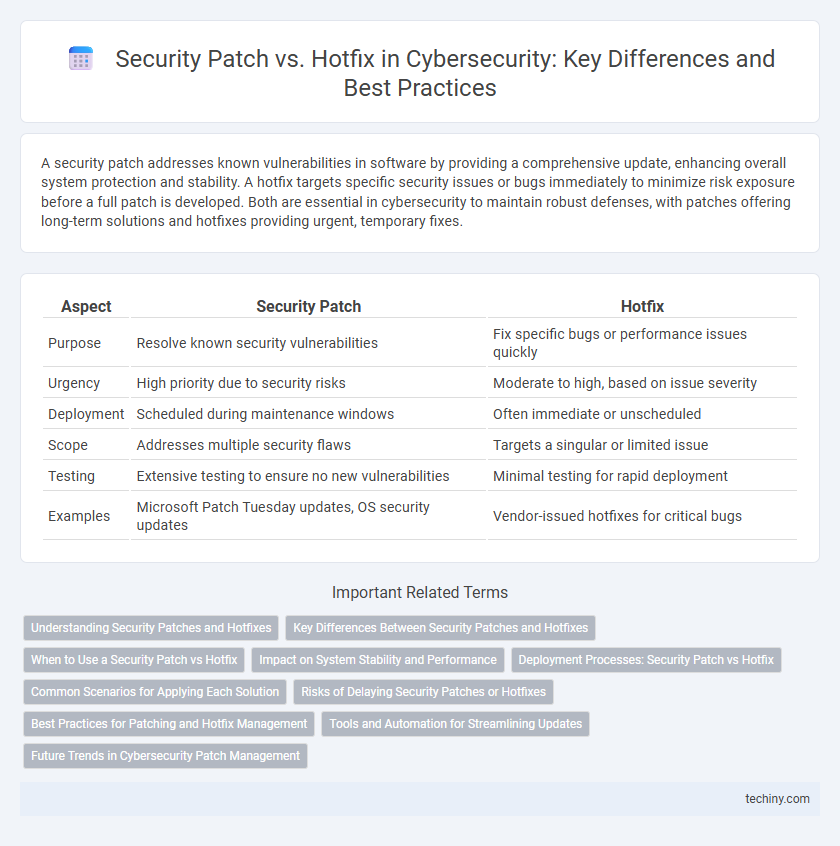A security patch addresses known vulnerabilities in software by providing a comprehensive update, enhancing overall system protection and stability. A hotfix targets specific security issues or bugs immediately to minimize risk exposure before a full patch is developed. Both are essential in cybersecurity to maintain robust defenses, with patches offering long-term solutions and hotfixes providing urgent, temporary fixes.
Table of Comparison
| Aspect | Security Patch | Hotfix |
|---|---|---|
| Purpose | Resolve known security vulnerabilities | Fix specific bugs or performance issues quickly |
| Urgency | High priority due to security risks | Moderate to high, based on issue severity |
| Deployment | Scheduled during maintenance windows | Often immediate or unscheduled |
| Scope | Addresses multiple security flaws | Targets a singular or limited issue |
| Testing | Extensive testing to ensure no new vulnerabilities | Minimal testing for rapid deployment |
| Examples | Microsoft Patch Tuesday updates, OS security updates | Vendor-issued hotfixes for critical bugs |
Understanding Security Patches and Hotfixes
Security patches and hotfixes are critical components in cybersecurity for addressing vulnerabilities and maintaining system integrity. Security patches are official updates released by software vendors to fix known security flaws, often undergoing thorough testing to ensure stability and compatibility. Hotfixes, by contrast, are emergency updates applied quickly to resolve specific issues, typically targeting urgent threats with less extensive testing but essential for immediate protection.
Key Differences Between Security Patches and Hotfixes
Security patches are comprehensive updates designed to fix vulnerabilities by addressing multiple security flaws systematically, whereas hotfixes target specific issues quickly, often resolving an immediate threat or bug without waiting for the next scheduled update. Security patches undergo extensive testing to ensure stability and compatibility across systems, while hotfixes prioritize rapid deployment to mitigate critical risks that may compromise system integrity. Both are crucial in cybersecurity maintenance, but their implementation timing, scope, and testing rigor differ significantly.
When to Use a Security Patch vs Hotfix
Security patches are essential for addressing critical vulnerabilities affecting system integrity and are recommended for broad deployment during scheduled maintenance windows to ensure stability and thorough testing. Hotfixes are designed for urgent, targeted fixes when immediate response is required to mitigate specific security threats or system failures without waiting for the next standard update cycle. Choosing between a security patch and a hotfix depends on the severity of the vulnerability, the risk of exploitation, and the organization's tolerance for downtime during implementation.
Impact on System Stability and Performance
Security patches undergo extensive testing to ensure they enhance system stability and address vulnerabilities without degrading performance. Hotfixes are typically released quickly to resolve critical issues and may carry a higher risk of introducing instability or performance degradation due to limited testing. Implementing security patches is generally safer for maintaining system reliability, while hotfixes serve as urgent, temporary solutions that require subsequent thorough updates.
Deployment Processes: Security Patch vs Hotfix
Security patches undergo thorough testing and validation through formal deployment processes to ensure system stability and comprehensive vulnerability mitigation, typically managed via scheduled release cycles. Hotfixes are rapidly developed and deployed to address critical security flaws or operational issues, often bypassing extensive testing phases to minimize exposure time. Deployment of security patches involves structured change management and rollback plans, whereas hotfix deployments prioritize immediate risk reduction with expedited installation procedures.
Common Scenarios for Applying Each Solution
Security patches are commonly applied during scheduled maintenance windows to address widespread vulnerabilities affecting multiple systems, ensuring comprehensive protection against known threats. Hotfixes are typically deployed immediately to resolve critical, isolated issues that compromise system stability or security without waiting for formal patch cycles. Organizations prioritize hotfixes for urgent bugs impacting production environments, while patches are rolled out for broader, less time-sensitive updates.
Risks of Delaying Security Patches or Hotfixes
Delaying security patches or hotfixes significantly increases the vulnerability window, exposing systems to exploitations such as ransomware attacks, data breaches, and unauthorized access. Unpatched security flaws can be leveraged by threat actors to escalate privileges, inject malware, or disrupt critical operations, amplifying the risk of severe financial and reputational damage. Timely deployment of patches and hotfixes is essential to mitigate these security risks and maintain robust cybersecurity defenses.
Best Practices for Patching and Hotfix Management
Implementing regular security patches is essential to protect systems from known vulnerabilities, while hotfixes serve as immediate, targeted solutions for critical issues that cannot wait for the next patch cycle. Best practices for patching and hotfix management include thorough testing in a controlled environment before deployment, maintaining an up-to-date inventory of assets, and prioritizing patches based on risk assessment and exploit availability. Automation tools and centralized patch management solutions enhance efficiency, reduce human error, and ensure timely application across all system components.
Tools and Automation for Streamlining Updates
Security patches and hotfixes require robust tools and automation solutions such as WSUS, SCCM, and Ansible to streamline deployment processes effectively. Automated patch management systems enable real-time vulnerability assessment, ensuring critical updates are prioritized, tested, and rolled out swiftly with minimal manual intervention. Integration with CI/CD pipelines enhances update accuracy and reduces downtime by facilitating continuous monitoring and rapid response to emerging security threats.
Future Trends in Cybersecurity Patch Management
Security patch management is evolving with increased automation and AI-driven vulnerability detection, enabling faster deployment of both security patches and hotfixes to mitigate zero-day exploits. Future trends emphasize predictive analytics to prioritize patch application based on risk assessment and threat intelligence integration. Cloud-native environments will leverage continuous patching mechanisms, reducing system downtime and enhancing real-time protection against emerging cyber threats.
Security Patch vs Hotfix Infographic

 techiny.com
techiny.com